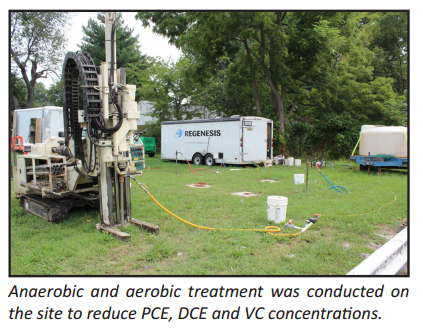ORC Advanced® Releases Oxygen Over 15 Months in Treatment Zone to Eliminate Daughter Products
Project Highlights
- All target compounds reduced to below Maximum Contaminant Level (MCLs) in onsite wells
- Anaerobic biodegradation using Hydrogen Release Compound (HRC®) treats tetrachloroethylene (PCE) and 1,1 dichloroethene (DCE) to below federal MCLs
- Aerobic biodegradation using ORC Advanced® treats vinyl chloride (VC) and 1,1-DCE to below MCLs
- ORC Advanced provided oxygen for a period of 15 months in the target treatment zone

Project Summary
The site is located in the Coastal Plain of South Carolina and is a former light industrial facility. Baseline concentrations of total chlorinated VOCs – which included PCE, dechlorination daughter products, and 1,1- DCE – were as high as 2,000 μg/L in the near-source groundwater.
Initial groundwater treatment injected 2,400 pounds of HRC at the site using direct push technology. VOC concentrations in the target monitoring wells decreased to below federal MCLs for all contaminants except for VC and 1,1-DCE, which appeared to have stabilized between 10-15 μg/L and 7-30 μg/L, respectively.
In an attempt to meet the MCLs for all contaminants and attain regulatory closure, the treatment approach was shifted to aerobic bioremediation to accelerate degradation of residual VC and 1,1-DCE. This approach was based on evidence that aerobic biodegradation of daughter products such as VC can be much faster than anaerobic processes. The aerobic treatment involved injection of 1,360 pounds of ORC Advanced via direct push technology into 22 temporary points.
Technology Description
ORC Advanced is a proprietary formulation of food-grade, calcium oxy-hydroxide that produces a controlled-release of molecular oxygen to enhance aerobic biodegradation.
HRC is a controlled release, electron donor material that, when hydrated, is specifically designed to produce a controlled release of soluble lactate. The newly available lactic acid is highly efficient for the production of dissolved hydrogen to fuel anaerobic biodegradation processes in soil and groundwater.
Results
After initial groundwater treatment of HRC and following application of ORC Advanced, groundwater monitoring showed reductions in VC to below MCL except for periodic detections between 2-3 μg/L and reductions in 1,1-DCE to below the MCL of 7 μg/L onsite. The VOC concentrations and the dissolved oxygen levels demonstrated that ORC Advanced released oxygen for 15 months in the target treatment zone.


 Americas
Americas Europe
Europe Français
Français Deutsch
Deutsch Italiano
Italiano Español
Español


